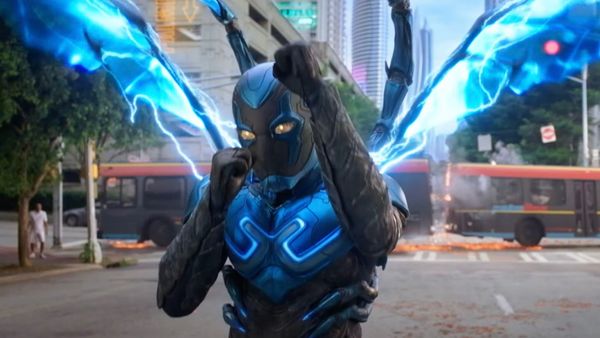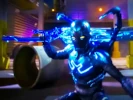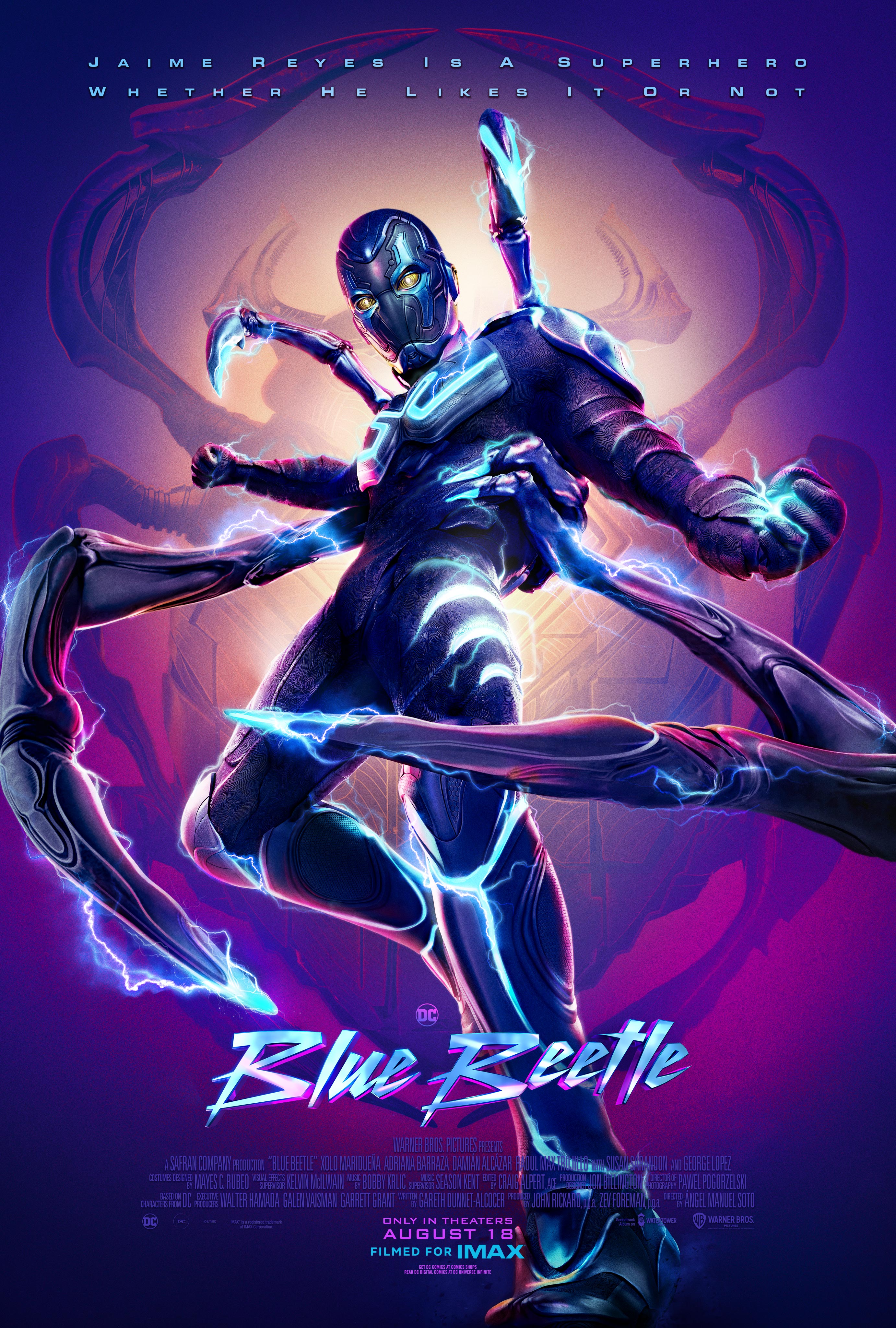Eye For Film >> Movies >> Blue Beetle (2023) Film Review
Blue Beetle
Reviewed by: Andrew Robertson

As a comic-book entity rather than a character, Blue Beetle has a long and complex history. Created in 1939, that makes him a contemporary of Batman, the Human Torch (not that one), the Sandman (not that one), and Ultra-Man (not that one). That Human Torch had their powers and origins changed to become one of the Fantastic Four. That Sandman was a direct inspiration to Neil Gaiman's Morpheus but they are not the same. That Ultra-Man is not the Japanese character whose rubber-suited growing-giant monster-fighting has been foundational to a whole television genre since (Bat-coincidence) 1966. Blue Beetle's greatest impact is probably a secondary effect too, as for reasons that are themselves indicative of how comic books work(ed) their biggest impact is probably inspiring both iterations of Nite-Owl in Watchmen.
That's 'both', because Blue Beetle was created for Fox Comics as an alter-ego of Dan Garret(t), who is mentioned in the film as an Egyptologist. Fox Comics became part of Charlton, and there he was the alias of Ted Kord. 'Became part of' because there's still not solid evidence of a transfer of rights, which will be important later. Where first powers had been granted by a mystical insect - sorry, a 'sacred scarab' - they were now granted by traditional science hero abilities like shopping in special catalogues and being a billionaire industrialist. If that sounds familiar then you're not alone.

When Alan Moore was drafting Watchmen, DC Comics, which had by this point acquired Charlton, decided that letting Moore use them directly would mean they couldn't be used for something else, and so new versions were created. While Moore (and Gibbons, whose art still stands up and whose lettering was an inspiration to Comic Sans) were creating, DC started to pull Charlton Comics into the Crisis On Infinite Earths. As they were doing that, the contracts for Watchmen included a reversion clause that meant when it went out of print the characters created by Moore and Gibbons based on characters created by (among others) Charles Wojtkoski, Steve Ditko, and (depending on source) maybe even Will Eisner would go back to them.
Watchmen has been in print continuously since 1986. That's 37 continuous years, and I mention it not only because the film release and the television series and prequel miniseries (all nine!) and the sequel were all at the behest of DC and didn't involve their original creators, nor the creators whose work inspired them, but because in addition to being indicative of that kind of exploitation of IP and creators, Blue Beetle has never managed a run anywhere close to it.
If I've got my maths right and have interpreted comics.org correctly, Blue Beetle has had eight publishers and been dropped (or at least not continued) 35 times. The longest single stretch was maybe 60 issues though there's a missing #43 and the publisher changed at least twice. When the character was resurrected (almost literally, as Ted Kord was killed off in 2005) as part of 'The New 52', he got to 36 successive issues and some collections and miniseries, and there's some new stuff this year tied to the film but I can turn my head from where I'm typing and see a box that contains more issues of Black Panther and round the corner from that is a shelf with more collected editions of Judge Dredd than even that. As superheroes go, Blue Beetle's not top-tier, even for DC, very occasionally appearing in stuff like Teen Titans or DC Super Hero Girls where he's effectively playing whatever comes after second-fiddle to household names like Zatanna and Nightwing.
Filmicly he's playing catch-up to Ant-Man. Or maybe Shang-Chi, but mostly Ant-Man. I find myself comparing it to the Marvel Movies because it's got many of the hallmarks: the tiresome banter, the over-use of purple for bad-guys. Add to that the ongoing symptoms of the Snyder-verse: muddy coloration, overwhelming amounts of effects shots, weird elements of corporate politics.
One of the antagonists was taught at 'The School of the Americas', now known as the Western Hemisphere Institute for Security Cooperation, an institution whose Wikipedia entry mentions in its fourth and fifth sentences associations with dirty wars, juntas, and human rights abuses. It's arguably not the first appearance in canon - in the vein of dirty deeds done dirt cheap by entities other than Iron Man, the DC character Fire had family connections to Operation Condor. Admittedly, that's in the ongoing escalation attached to Suicide Squad architect Amanda Waller, where there's always someone worse. Even then, it's an astonishing bit of the real world in a film that invents a Palmeira City somewhere in Texas that looks more like Shanghai than Houston. Though DC has form for that sort of civic ingenuity, Gotham is mentioned, other Metropolises are assumed, Jaime Reyes was originally from El Paso.
Director Angel Manuel Soto has helmed a feature before, but Twelve (aka Charm City Kings) a coming of age film set among Baltimore's crews of dirt-bike riders, was removed from (HBO) Max over a year ago. Writer Gareth Dunnet-Alcocer has written a feature before, Miss Bala, but he's credited solely for a film that's an English Language remake of 2011's Miss Bala, directed by Gerardo Naranjo who co-wrote with Mauricio Katz. The original's not available for streaming in the UK, but that remake is on all the services you'd expect. That's one of the reasons why I walked you through Blue Beetle's tortuous history as a publishing entity, because on this appearance it looks like all the same nonsense is going on. We've finally achieved in comic book movies in about 15 years what comic book titles took about 60 to manage. Everyone's being exploited and nobody's having fun.
Don't get me wrong, I laughed in a couple of places, but not as much as younger members of the audience. The public screening I went to was affected by technical difficulties that meant it often froze, so I can't confidently say that its 127 minutes will feel even longer for everyone. When it wasn't stuttering due to digital issues it was stumbling due to story ones. The ability to imagine weapons and make use of them is a direct lift from Green Lantern, at least by way of the Final Fantasy videogame series. Other sequences borrow from the Tom Holland Spider-Men and a variety of other Marvel titles.
Xolo Mariduena has had a recurring role in Karate Kid TV spinoff Cobra Kai, and has done a fair chunk of voice work including some comic book roles. He's charming, anchor to an extended family that feels like an attempt to synthesise Ant-Man's "X-Con Security Consultants" with the Shazam family (Shazamily?). George Lopez is one of several called upon to provide comic relief in a film that doesn't need it, I know I'd much rather watch a film about Nana Reyes and her revolutionary past. Played by Adriana Barraza, she's one of dozens in the cast for whom this could and should be a high-profile Hollywood role which would lead to other opportunities. As with Damian Alcazar's performance, what might be best bits are lost in a haze of special effects. Sequences that borrow from Black Panther and Deadpool squander an emotional moment in a bath of pixels.
Susan Sarandon is Victoria Kord, a name that you now know means something to someone. If you keep watching for a mid-credits scene it might mean something to someone else. I assume she was paid more than she might get doing pantomime in London, but she'd probably have more than scenery to dine upon there. Her henchman Carapax (Rauol Max Trujillo) is a mostly-man made menace, and between them Harvey Guillen is subjected to micro-aggressions that extend to the way his role is credited.
I didn't like its aesthetic choices. It seems to have complicated crisp designs in much the same way Michael Bay's Transformers greebled the lorry. I found some of the jokes lazier than they were puerile, and that includes the one about "a rush of blood to [a] midsection". Lopez as uncle Rudy drives a pickup truck with a La Cucaracha horn. It's a Toyota Tacoma that's known as the 'taco'. I don't know what the level below 'pun' is in things that approach wordplay, but you could probably clear it in a submarine.
Every flight sequence appeared to include the formation of a vapor cone. That doesn't necessarily mean supersonic speeds, but it is one of those fake realism things like lens flare in videogames whose artifice is obvious. I'll mention in the interests of pedantry that what are called 'air brakes' appear to be drogue chutes making use of para-sails, but maybe that labelling was in character. Air Supply's All Out Of Love is one of several musical choices that might have similar attribution, but their use reminded me unfavourably of the better outings for the Guardians Of The Galaxy.
The greatest good achieved is probably that production spent some time in Puerto Rico, making this one of, if not the, largest budget picture to film there. One of the fortresses used did remind me a lot of Chapter Five of Red Dead Redemption 2, but that's hardly surprising given that they were both built by the Spanish Empire. The abundant use of CG doesn't help either. All that for a sequence involving a walking tank, Motley Crue's Kickstart My Heart and a fart joke. This was well after being annoyed that a bit of graffiti was impossibly achieved with a single rattle-can.
Despite all that, and I know it's a lot, I didn't hate it. I didn't much like it either, if that wasn't clear enough. It was entertaining in places, but I spent most of the film disappointed. It represented opportunity wasted, but at least when I spend a few sweeps of the clock badly I can use a bit more to produce a review. To give new talent these budgets and underexplored characters and knock out this kind of assembly line nonsense is what got printed comic books into the doldrums that they're still in. This despite the medium being wide enough that it includes stuff like Snowpiercer and David Fincher's forthcoming The Killer, beyond the four-colour nonsenses of Tank Girl and Aquaman. When I think about what Robert Rodriguez achieved with CGI heavy films like Shark Boy & Lava Girl on budgets vanishingly smaller than this, it feels, like goodbyes surrounded by floating rocks, a waste.
Comic books as an industry, like many others, rely on love to paper over any number of cracks. Valorising sacrifices as part of the price of participation masks decades of corner-cutting and rip-offs and other things with hyphens. The reputation of some artists for poor quality misses that what the industry wanted was delivery to timetable. The old saw of "faster, better, cheaper: pick two" misses that at every turn capital will choose the latter, and it's not fussy about anything else. It isn't hack-work, but it is a drudge, not so much pencilled as leaden. As it stands it's probable that Blue Beetle will, again, become associated with industry failings. As I write this it's still about 20 million dollars shy of making back its budget, but given that there's no fiction in Hollywood like accounting, I'm reserving judgement.
Blue Beetle is meant to herald James Gunn's DCU, and it has a scene at the end that is doubtless meant to set something up, but even appearing only a bit of the way into the credits it played to a theatre in which I was alone. With production and release slates in flux due to strikes, who knows who will be the next superhero to be brought forth and set against the world? That is (though it probably won't be) the question.
Reviewed on: 01 Sep 2023

















